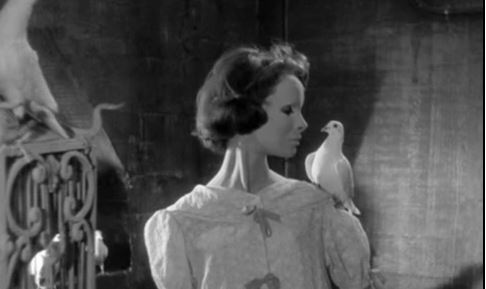“What goes on after hours in that cinema of yours?”

If many of Hitchcock’s later films had not been so astounding, perhaps this offering from 1936 would be far better known. It certainly deserves to be. Many of the themes and tropes which would come to define Hitchcock’s films are already here: the icy blonde, the innocent man who is wrongly accused and the narrative ‘wrong footing’. Sabotage actually contains one of Hitchcock’s more shocking and unexpected reveals, one that the director himself was conflicted over. Following the relatively light-hearted screwball elements of The 39 Steps and The Lady Vanishes, where a slightly kooky romantic pairing offers a cornerstone to the more serious suspense and action, here things are considerably more restrained.
Sure, there is a romantic flowering between the two main characters, but this is a pairing more in tune with the less fantastical plot. The story of Mr. Verloc (Oscar Homolka) and his treacherous involvement with foreign agents (for he is the saboteur of the title) just about remains within the realms of everyday plausibility, taking place in a minimum of locations, that lacks the travelogue proto-James Bond feel of The 39 Steps or the much later North by Northwest.
At the beginning of the film we’re introduced to a successful attack on London’s electricity grid, and to Verloc’s involvement (which is never truly explained. What are his motives?) Despite being spotted coming in through the backdoor by his wife (Sylvia Sydney), which is untypical, he lies to her about his whereabouts and our seeds of suspicion are firmly planted. The Verlocs are the owners of a London cinema, which must have felt quite novel in 1936 and lends the film a degree of subversion; Mr. Verloc’s genuine affairs are likely more shocking than the fictions on the silver screen.
A memorable meeting between Verloc and his contact in an aquarium (with a blink and you’ll miss it appearance from Carry On’s Charles Hawtry) tell us little about the villains’ nationality. This was probably deliberate, although in the build up to World War II we can make some educated guesses. Verloc is instructed to take possession of some explosives and how to use them, with the stress on making this a success. “They must not laugh…” This cannot be anything other than a successful terrorist act, which the populace and media will take seriously.
Sometimes Hitchcock deliberately led us down a narrative path that indicated the true villain was someone other than it actually was, such as influencing our suspicion of Norman Bates’ mother being the perpetrator in Psycho. But here, Verloc is most definitely the antagonist, and instead of playing with the audiences’ narratively constructed prejudices, instead focuses on his wife’s growing realisation that her husband is a killer. Many of Hitchcock’s films feature women in relationships with bad men that they cannot escape, to the extent that in Notorious the woman eventually becomes a literal prisoner. Mrs Verloc’s growing unease and eventual paranoia over her husband’s activities fuel the film and the introduction of Detective Sergeant Ted Spencer (John Loder) compounds her suspicions; her husband is evidently being investigated. From all these suspicions Hitchcock weaves his tapestry of suspense quite effectively. Ted initially operates undercover but a growing affection with Mrs Verloc soon blossoms into something else, in an earnest and touching way not really present in the aforementioned coupling in The 39 Steps.
The suspenseful centrepiece of the film is one that Hitchcock himself was quite critical of, suggesting the sequence could have been more effective. It does lead to one of Hitchcock’s more sombre and shocking moments. Mr. Verloc ropes in his wife’s young brother Stevie (Desmond Tester) to act as a courier, carrying the deadly package to Piccadilly, where the bomb is set to go off at 1:45pm. Unexpected delays along the route will have you knawing at your fingers, not least because of the regular clock updates. Never have the hands moved so slowly to the doomed time. Stevie is detained by a market salesman, a police officer and general crowds, all going about their business, but it leaves the boy fatally delayed. Although this centrepiece scene occurs without Mrs Veloc, it is that character who I was eager to get back to, to see her responses. Sydney’s performance is key to the film’s success and her subtle portrayal of the wife more than makes up for any of the film’s narrative failings.
You see, there are some things in Sabotage that clearly don’t make sense. Why would an experienced police detective bungle his eavesdropping on the terrorists by sticking his hand through a window? Why did Mrs Verloc ever marry Mr. Verloc, who she seems to share zero romantic chemistry? Often, Hitchcock presents things ‘just because’ they will help further the story and rack up the suspense by ensuring certain things will happen. I’m not convinced that it’s a heavier handed way of telling a story that Hitchcock ever truly abandoned, but I can just about let those implausible actions go in the broader context of the story being told.
Even with its irrational moments, and it isn’t the only Hitchcock film to have them, Sabotage is one of Hitchcock’s finest early pictures. The film is very effective in communicating the mood of a city just three years away from an huge unavoidable conflict, and one of his last British films before Hollywood finally poached him.

